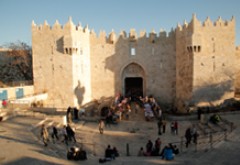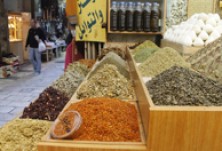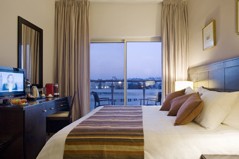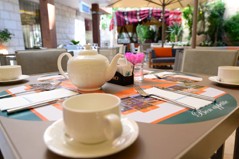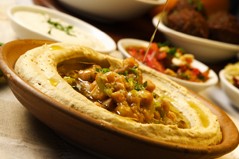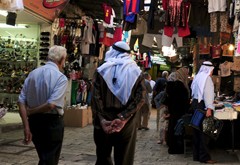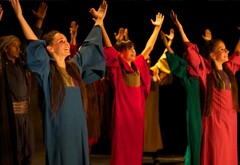With the fall of the Ayyubids, the dawn of a new political era appeared as the Mamluks controlled Jerusalem for over two and a half centuries. The Mamluks (1250 - 1516 AD) formed a new phenomenon in human history as a whole, being slaves in origin.
Some of the main architectural signs of civilization in Jerusalem today are from the Mamluk period, with Mamluk buildings, including schools, hostels, souqs (markets), Zawia's (ethinic religious centers), Sabils (drinking water fountains), Ribats (Sufi centers), and religious schools, being Jerusalem's architectural jewels. These amazing buildings were preserved relatively better than any other Mamluk city. Although Jerusalem was architecturally united with other cities in Bilad Al-Sham (Greater Syria) and Egypt during this period, we notice architectural specificities in Jerusalem, which are compatible with the local heritage, without discarding its general Mamluk style.
With the Mamluks, their religious property and institutions, Jerusalem made a civilizational quantum leap of the first kind. If we thought that the bright eras of the city started with Herod, who formed its first stages, then the Umayyads formed the second stage, while the Mamluks formed the third stage. No Herodian building remained intact in Jerusalem, while some Umayyad buildings remained standing, such as the Dome of the Rock, parts of Al-Aqsa Mosque, the Chain Dome, the eastern basement / Al-Marwani prayer site, and some gates of Al-Haram Al-Sharif, while dozens of Mamluk buildings remain, ornamenting the city in its various parts, particularly in Al-Haram Al-Sharif and its vicinity.
Among the features of the cultural renaissance of the Mamluk Jerusalem is this huge number of houses of science spread around the Old City, numbering 27 schools, in addition to Zawias, Ribats, Khanqahs, and Al-Aqsa Mosque and its courtyards, which were also used for scientific purposes such as research and teaching. These educational institutions turned Jerusalem into an unprecedented scientific center, with the most prominent scholars of the Mamluk era arriving to study and teach in its schools, established by sultans, princes, and philanthropists, such as sultan Qaitbay (Al-Ashrafiyyah School in 1480), Prince Tankaz Al-Nasiri (Al-Tankaziyyah School in1328), the Dawadar (the Dawadari School in 1295), and others. It is also noteworthy that women also contributed to this process of building Jerusalem, with SittSufrahKhatun building the Barudiyyah School in 1367, AghalKhatun Al-Baghdadyah building the Khatuniyah School in 1380, and Isfahan Shah building the Ottoman School in 1473, not to mention women's tombs and palaces.
Needless to say, Mamluk buildings sprung up around the city, but were concentrated around the northern and western sides of Al-Haram Al-Sharif, and along the main axes that lead to it, such as Bab Al-Silsilah street (the Chain Gate), Bab Al-Hadid street (Iron Gate), Souq Al-Qattanin (Cotton Traders' Market), Al-Mujahidin Street (Holy Warriors) …etc.
Visitation activity to Jerusalem grew during this period and almost reached the numbers of pilgrims to Mecca and Medina, which required the construction of hostels and retreats, including Al-MansuriRibat, built by Sultan Qalawun in 1282. Virtuous books were written describing the religious and historical qualities of Jerusalem by more than thirty thousand authors. With the growing religious dimension of Jerusalem, the city became a destination for Sufis, and Mamluk sultans encouraged this phenomenon by building larger numbers of Sufi homes, such as Zawias, Ribats, and Khanqahs to cater for this demand, such as Al-Zawia Al-Bustamiyah in 1369, Al-Zawia Al-Wafa'iyah in 1380, and Al-Zawia Al-Naqshabandiyyah in the fifteenth century, as well as others.
What further connected the Mamluks to Jerusalem is the use of the city as a center for the 'misfits;' those who were banished, and who were deprived of their military ranks and their right to interfere in public affairs, and many princes, who the sultan worried about their influence and rebellion. Some of those who came to Jerusalem became important sultans and princes, spending lavishly on the city and contributing to building public and charitable institutions.
There is no doubt that Mamluk Jerusalem developed its economic resources to a large extent. The development in building hostels and Ribats, both Islamic and Christian, reflected widespread pilgrimage and visitation activities, resulting in an increase in handicrafts production, particularly as related to souvenirs. Furthermore, visitors paid entry fees and other charges which invigorated the economy. Souq Al-Qattaneen (the cotton market) where the production of cotton and silk textiles was concentrated, formed a vibrant economic gateway for international trade in the city, particularly that developed with Egypt and Bilad Al-Sham. There are important historical indications regarding the soap industry in Jerusalem, which prospered during the Mamluk period. The large revenues, however, came from the rich Awqaf (religious property) whose income was dedicated by Mamluk sultans and princes for the city's holy sites and institutions. The same applied for the rich and scholars, thus generating plentiful employment opportunities.
Towards the end of the fifteenth century, the Mamluk Kingdom was suffering from a severe financial crisis after the discovery of the Cape of Good Hope and their loss of their lucrative commercial monopolies in the spice and incense trade, and as a result of the growth of a great world empire (the Ottoman Empire) along their northern borders. This unique kingdomcollapsed in the battle of MarjDabeq before the young Ottoman army in 1516, opening a new era which controlled Jerusalem for four centuries, and heralding an intimate relationship between Jerusalem and the sultans of Bani Othman, with the visit by Sultan Salim I to Jerusalem two days after it was conquered (28 October 1516).

